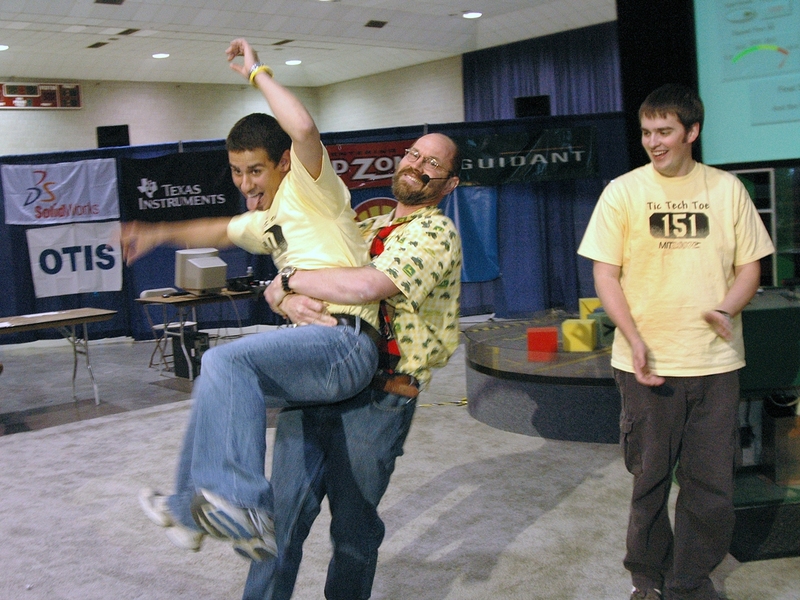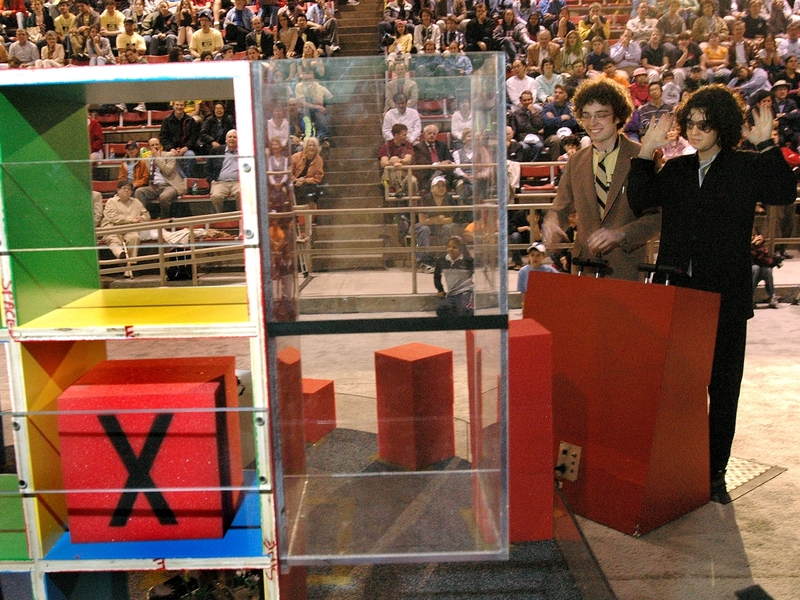Mark Cote's squeezer-grabber-thingy-bopper ruled over Robert Panas' flipper-upper-doo-hoppy in the final tie-breaking rounds of Tic-Tech-Toe, the robot competition for mechanical engineering students in course 2.007, held on Friday, May 13, in the Johnson Athletic Center.
Cote and Panas, the first- and second-place winners, are sophomores in mechanical engineering. To ordinary eyes, their 10-pound machines suggested forklifts and catapults. But 2.007 is a transformative experience. Even language lightens up for it.
Thus third-place winner Philip Dawson, a sophomore in mechanical engineering, used a "gripper-attacker" design, while Sang Nguyen, a junior in mechanical engineering, employed speed and an innovative "windshield wiper of doom" to block his opponents' blocks.
Alexander Slocum, professor of mechanical engineering and MacVicar Faculty Fellow, emceed the three-hour event, providing free-form commentary on each machine as the competition intensified.
"Repeatability! Infinite cosmic power! This is where physics meets the carpet!" he called out to the students, parents, fans and friends who packed the stands for the annual competition.
Many other items met the carpet during the evening, including the hands of students randomly asked to do push-ups and the contents of the kit from which all 130 machines were built during the spring term. Slocum likened the kit to an engineering student's brain.
"We start with real materials, raw materials. We want to get your brains to dump out all your knowledge and mix it up," he announced, piling objects at his feet to demonstrate what "thinking outside the box" means.
Tic-Tech-Toe, composed of elimination rounds of 45 seconds each, required each student, using items from the kit, to build a machine to gather 8-inch foam-rubber blocks and place them inside 16 vertically stacked bins before frustrating its opponent machine.
The bins were arranged and painted like Simmons Hall, the award-winning new dorm on Vassar Street. A block in a floor-level bin yielded 10 points; the point-value rose with the bins' "floor" in the grid, and also if a block's single "X" or "O" marking was visible to the audience. Clear four-story bins at either side of the grid--worth 80 points each--lured major forklift-and-drop action.
Fifth-place winner Derrick Tan, a junior in electrical engineering and computer science, ignored the four-story "infinite airspace option" and built a double-blocker-fighting machine whose motors lived purely for "raw pushing power and speed. Overall, the night was a blast," he said.
Graduate student judges and undergraduate teaching assistants kept careful track of scoring and general machine conduct.
On a fashion note, several male contestants wore suits over their street gear this year, and two women wore intricate balloon hats. MIT President Susan Hockfield and her husband, Thomas Byrne, took it all in wearing Hawaiian print shirts and baseball caps.
Sixth-, seventh- and eighth-place winners were, respectively, Mark Eagan, Jesse Marsh and William Etheridge, all sophomores in mechanical engineering.
The top five winners of Tic-Tech-Toe will go to the International Design Contest (IDC), held this year in Japan. The IDC is like 2.007, only the teams are composed of students from different countries, which means drawings and physics, rather than words, are used to communicate machine design.
A version of this article appeared in MIT Tech Talk on May 18, 2005 (download PDF).







